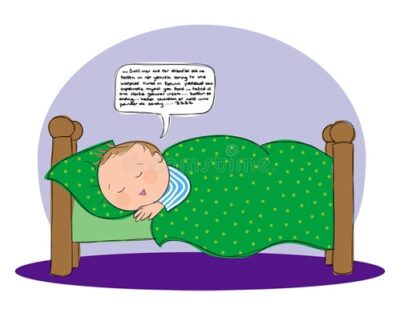In an unusual new study, researchers asked sleeping lucid dreamers to solve simple math problems. Some did. When they asked these dreaming people yes/no questions, some answered–using a raised eyebrow or a smile. The researchers call this 2-way communication “interactive dreaming.” Its potential could be wide-ranging.

Source: Dreamtime.com
The experiment, published in Current Biology in February 2021, involved 20 scientists on four independent research teams in four countries: the U.S., Germany, France and the Netherlands. In total, they tested 36 dreamers, during 57 sessions, making 158 communication attempts. The dreamers were people with little or no experience with lucid dreaming, experienced lucid dreamers, and one lucid dreamer with narcolepsy. Dream sessions happened during night time sleep as well as daytime naps.
Training the Brain for Lucid Dreaming
Before the experiment, they taught the inexperienced dreamers how to lucid dream. Also, they practiced answering questions with the pre-arranged facial expressions and eye movements but were not told what questions would be asked.
Three of the four teams used different methods to question the dreamers. One asked math questions using Morse code and multi-colored lights. Two teams verbally asked the math questions. The other team verbally asked yes/no questions. In all sessions, dreamers were to move their eyes in a pre-determined way to signal when they were lucid (aware that they were dreaming). However, that happened in only 26% of the sessions. Also, some wake up when being spoken to. Consequently, they based their final results on only the cases where dreamers signaled and the signal was verified by the brain wave data being recorded.
For example, after one inexperienced dreamer moved his eyes to show he was lucid, researchers asked, what is 8 minus 6. Within 3 seconds, “he responded with 2 left-right eye movements (LRLR) to signal the correct answer.” The same problem was asked again. Again, he answered correctly.
In another case. The narcoleptic lucid dreamer was asked yes/no questions. He answered correctly using a smile for no and a raised eyebrow for yes. He answered 4 of the 5 questions, 2 correctly and 2 answers were ambiguous. In his waking report of the session, he repeated the questions the experimenter had asked.
In a third case, an experienced lucid dreamer was “presented visual stimuli consisting of alternating colors and a corresponding Morse-coded math problem 4 minus 0.” He answered with the correct number of eye movements, but in his waking post-dream description said he had heard the question as 4+0. He also reported knowing the flashing lights were math problems, but sometimes they were too fast to decode.
Interactive Dreaming Proof of Concept
Overall, there were 29 correct responses from 6 different individuals—at least one from each team. Also, during day and night sleep. The researchers call the results “proof of concept of two-way communication during sleep.” Most people couldn’t do it. But clearly, it can be done.
Receiving and answering questions engages high-level cognitive skills. Skills that were previously thought impossible while sleeping. Lucid dreamers were able to remember instructions given during waking and apply them while sleeping. They were able to calculate, to answer the math questions and were able to access memories of their waking life to correctly answer the yes/no questions. So, aside from deepening sleep and dreaming research if dreamers can offer real-time information from the dream state, what do these experimenters think the potential, someday uses are?
Potential Uses of Interactive Dreaming
Interactive dreaming could be used to solve problems and enhance creativity, they speculate, and to learn new facts and skills. Previous studies suggest dreaming about athletic or musical ability when it’s being developed in wake life can enhance performance. In my own experience, dreams helped me solve problems. Usually that happened by simulating scenarios in the dream and seeing how they played out or rehearsing different responses to complex social situations.
The experimenters say artists and writers might gain inspiration from sleep communication. As I wrote in another post, artists, writers, scientists and other creative people have long found solutions and new directions through dreams and daydreams.
Healing Using Dreams
They suggest interactive dreaming could be used to reduce effects of emotional trauma and find novel ways to promote health and well-being. At the end of January, I listened to an Institute of Noetic Sciences webinar announcing a study they plan to do to see whether healing intention in a lucid dream can actually heal people in waking life. I’ve experienced this, and even experienced actual healing “in” dreams.
As a kid and until about my mid-twenties, when I was in pain or emotionally upset, I slept. For many, many hours. When I woke up, I was pain-free or in a re-balanced mood. I usually didn’t set an intention for healing, and I don’t recall remembering what happened in most of the dreams, so they weren’t lucid. But they show me that some kinds of healing can happen during the dreaming state.
They say combining the “creative advantages of dreaming with the logical advantages of waking, cues may be devised to influence dream content” for any of these purposes. Understanding the dream process as we’re dreaming may even “open up new ways to address fundamental questions about consciousness.”
